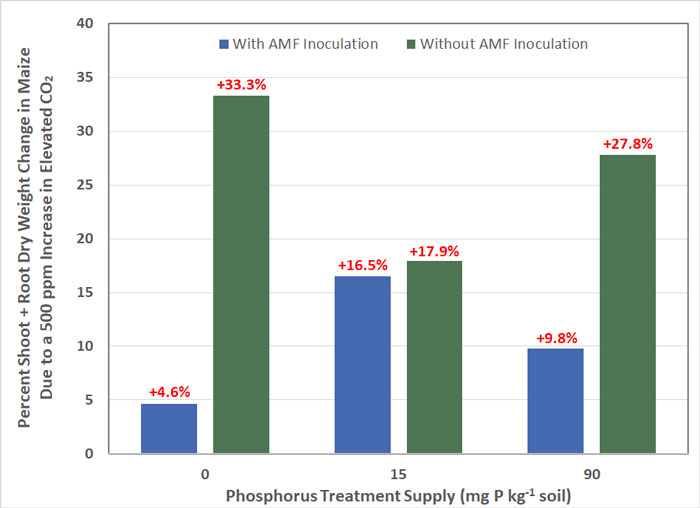| Tweet | Follow @co2science |
Paper Reviewed
Watts-Williams, S.J., Smith, F.A., and Jakobsen, I. 2019. Soil phosphorus availability is a driver of the responses of maize (Zea mays) to elevated CO2 concentration and arbuscular mycorrhizal colonization. Symbiosis 77: 73-82.
Arbuscular mycorrhizal fungi (AMF) maintain a symbiotic relationship with certain plants in which they provide the plants with valuable soil nutrients and in return receive carbon resources. The end result is that both plant and fungi growth is enhanced.
In a recent study Watts-Williams et al. (2019) set out to explore the interactive response between AMF, soil phosphorus (P) supply and atmospheric CO2 concentration on the growth of maize (Zea mays, cv. B73). Their experiment was conducted in pots in controlled indoor environments over a period of 40 days. AMF treatments included with or without inoculation, soil P supply treatments included 0, 15 or 90 mg P kg-1 soil and atmospheric CO2 treatments included 400 or 900 ppm.
In discussing their findings, the scientists report that maize shoot and root dry weights increased with P supply and CO2 concentration, albeit the increases were more noticeable and significant for shoot dry weights than they were for the roots. As shown in Figure 1 below, elevated CO2 had a positive impact on combined shoot plus root dry weight, regardless of P treatment supply or AMF presence. The greatest relative CO2 increase in dry weight (+33.3%) occurred in maize plants growing without AMF inoculation in the no P added treatment. In contrast, the smallest CO2 growth response (4.6%) was observed in plants subjected to AMF inoculation in the no P added treatment.
The take-home message of this work is that, regardless of P supply or AMF presence, rising atmospheric CO2 concentrations will likely enhance the growth of maize plants. And knowledge of the growth relationships among the variables examined here will help scientists and farmers select the best possible growing conditions to maximize future yields. What is more, the observations report here, in the words of the authors, add to the "growing body of literature that challenges the classic theory that C4 plants [like maize] are non-responsive to elevated CO2."

Figure 1. Percent increase in dry weight (shoot plus root) due to a 500 ppm increase in atmospheric CO2 concentration for Zea mays plants grown with (blue bars) or without (green bars) AMF inoculation and at different soil P supply treatments (0, 15 or 90 mg P kg-1 soil). Source: Derived from Watts-Williams et al. (2019).




